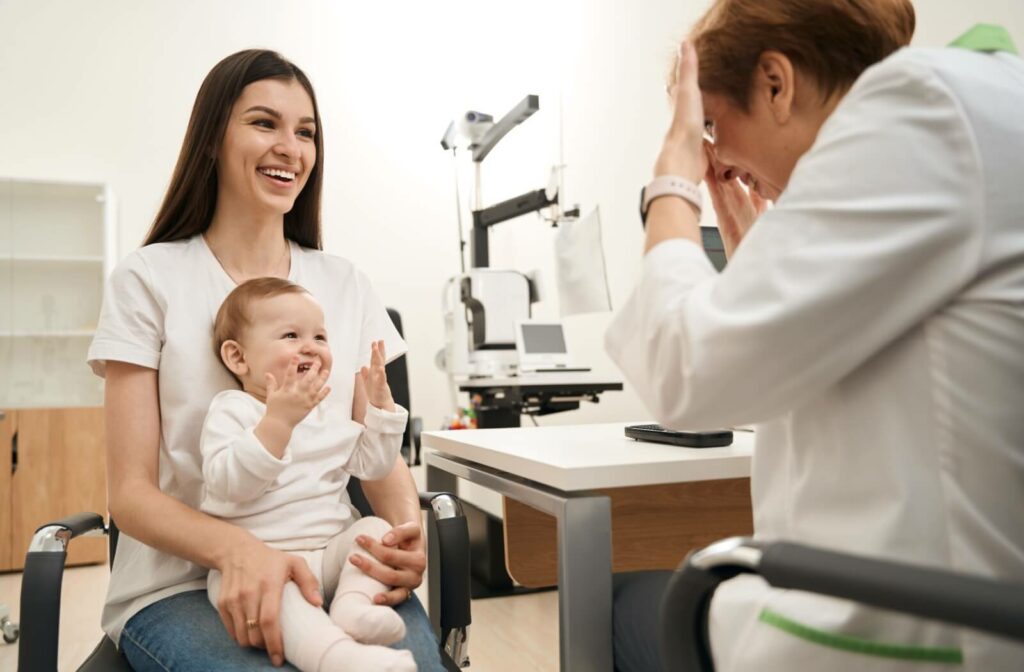From the moment we’re born, our eyes work to capture and process the incredible world babies are so new to. At birth, the human eye is tiny!
The eyes grow rapidly during infancy and early childhood. Your eyes continue to grow until young adulthood, but this happens much more slowly. Genetics, lifestyle, and eye diseases can significantly shape your visual health throughout this growth period.
The eye stops growing in adulthood. However, it still undergoes age-related changes, affecting vision and eye health.
A journey full of changes requires one reliable constant: a routine eye exam.
Foundations of Sight: Early Eye Development
At birth, an average human eye measures about 16.5 millimeters (0.65 inches) in diameter and grows quickly during the first 2 years. Though small, the eyes are anatomically complete. However, their ability to see is limited compared to what they will develop over time.
A newborn’s visual world is blurry, and they can only focus on objects about 8 to 10 inches away. The proximity is strategic, allowing babies to see their caregivers’ faces during feeding and bonding, nurturing essential emotional connections.
Significant milestones occur during infancy.
Babies start developing hand-eye coordination, depth perception, and the ability to recognize faces and colors. At around 6 months, their visual clarity improves dramatically, and they can focus on distant objects and follow moving objects.
Regular exams during this period help set the foundation for lifelong eye health. Your eye doctor can help detect and treat problems while the eye is still developing, allowing them to start practicing visual skills early. Luckily, kids can have their first eye exam as early as 6 months!
What Shapes Our Vision: Factors Affecting Growth & Development
Despite having a strong foundation, several factors can still affect the rate and extent of eye growth as the journey continues.
Genetics
People naturally have unique eye shapes and sizes, shaped by genetic diversity. For example, certain populations may have distinct eyelid shapes, which can influence how their eyes look and develop over time.
A family history of certain eye conditions, like refractive errors, cataracts, or glaucoma, means a person is more likely to inherit them.
While we cannot control genetics, regular eye exams can identify these tendencies early, making treatment and vision correction easier and more effective.
Environment
Although genetics aren’t within our control, you can make a difference with lifestyle habits.
Spending excessive time on digital screens, for example, has been linked to a rise in childhood nearsightedness (myopia). On the flip side, spending time outdoors has been proven to reduce the risk of developing this refractive error.
Parents should encourage outdoor play, balance screen time, and take breaks from prolonged focus work to reduce eye strain and promote healthy eye development.
Your diet can also support eye development and help prevent diseases. Key vitamins and nutrients include:
- Lutein & zeaxanthin
- Vitamin C
- Vitamin E
- Essential fatty acids
- Zinc
Eye Diseases
Certain eye diseases and conditions can emerge during childhood or adulthood, significantly affecting growth and vision.
Your child’s eye doctor can identify conditions like congenital cataracts, glaucoma, strabismus (crossed eyes), or amblyopia (lazy eye) through routine eye exams.
When your eye doctor diagnoses conditions early, your child can receive treatment that works with their natural development to improve outcomes and reduce the risk of lifelong vision problems.

Growing Vision: Childhood & Beyond
By age 3, after the initial rapid growth period, the eyes are approximately 22 millimeters (0.87 inches) in diameter (nearly reaching adult size). Your eyes continue to grow, but at a slower pace.
The eye undergoes subtle yet essential changes as its structure and function refine. When children reach school age, their visual system becomes more coordinated, allowing smoother hand-eye coordination and improved depth perception.
Throughout adolescence (ages 8–18), certain factors can start to influence long-term eye health. During this time, kids may develop refractive errors. Annual routine eye exams can identify, correct, and manage vision conditions through options like glasses or myopia control therapies.
By the time a child reaches their teenage years, their eyes have reached adult size. However, changes to shape or structure can still occur, particularly during rapid growth, such as puberty.
Finally, by young adulthood (ages 18–21), the eyes have typically reached their full physiological size and development. However, eye weight continues over time. Although refractive errors may progress slightly during this time, their vision prescription gradually stabilizes.
The Mature Eye: Growth in Adulthood
Although your eyes’ physical size remains mostly unchanged after adolescence, they continue to evolve in other ways during adulthood. Mainly, the natural aging process often begins changes, such as:
- Presbyopia, or the difficulty focusing on close objects, typically begins around age 40 as the eye’s lens becomes less flexible
- Age-related conditions, like cataracts or macular degeneration, are more common in your 50s & beyond
- Eyes may also become drier due to reduced tear production (dry eye), especially for people who spend a significant amount of time on digital devices
Adopting healthy habits, such as wearing sunglasses to shield your eyes from UV rays, eating a balanced diet rich in vitamins, and avoiding smoking, can promote long-term eye health.
While these changes are normal, they don’t have to diminish your quality of life. Regular check-ups enable early detection and management of age-related eye issues, allowing you to maintain clear vision and healthy eyes.
Prioritize Your Vision at Every Stage of Life
From infancy to adulthood, your eyes undergo incredible growth and transformation. Learning about the visual changes and factors that influence your eye health can help support your vision throughout your life.
One thing is for certain: whether you’re supporting your child’s visual development or caring for your aging eyes, routine eye exams can help maintain and support healthy eyes and vision now and in the future.
Connect with our team at Eye Care Plus to schedule your next routine eye exam.



